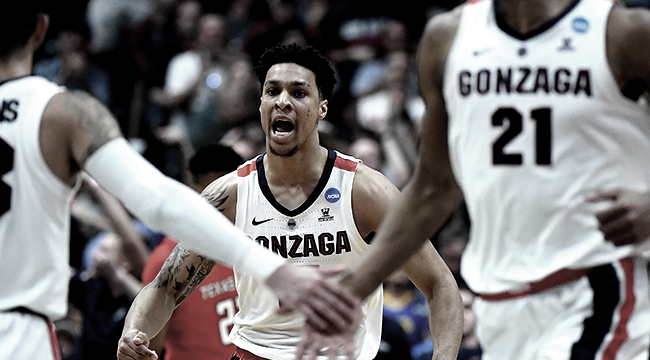
With the Final Four set and Zion Williamson’s collegiate career dead and gone, the scouting process for the 2019 NBA Draft is all but over. All that’s left are the lottery and the inevitable arguments over players, both on social media and, it’s safe to assume, in the offices of NBA decision makers. In terms of individual players, don’t be surprised to see a gigantic debate surrounding Gonzaga big man Brandon Clarke. While he hasn’t declared for the draft yet, he has a résumé that screams lottery pick: Clarke was the second-best player in America this past season and was named the Defensive Player of the Year and Newcomer of the Year in the West Coast Conference.
Yet debate still persists. Detractors point to his size (around 6’9 in shoes with a probable sub-7-foot wingspan), age (he turns 23 in September), and relative lack of experience and ball skill as points against him. Those are all reasonable concerns, but I didn’t just call him the second best player in the country for nothing. Clarke had one of the best seasons in recent college basketball history, tying Anthony Davis for the second highest Box Plus-Minus (BPM) since the metric started getting tracked in 2011. It is, to put it generously, a terrible oversight that he was merely an AP third-team All-American.
He won’t be a top target for a number of teams, who might be more inclined to draft a younger, more projectable player. But so often in this business, we overlook what a player can do for what they cannot, and the things Clarke can do are nothing short of prodigious.
Any evaluation of Clarke has to start with his absurd, almost surreal vertical explosiveness. I’ve described it as “Gerald Green-like” before, where it almost doesn’t even look like he’s jumping all that hard, but before you know it, he’s staring down into the rim and blocking your shot into the seventh row. Combined with his terrific instincts and timing, it’s made him the unquestioned best rim protector in the country, capable of out-jumping and out-thinking drivers when they get into the paint (his block of Tennessee’s Yves Pons was a highlight of the 2018-19 season).
How well his 220-pound frame will hold up in the NBA is definitely a question mark, and may limit him to situational minutes at the five, like his closest statistical comp, Jordan Bell. But Clarke’s work ethic, hard play, and self-evident basketball IQ make him a much better bet than Bell ever was, and I loved Bell coming out of Oregon.
Offensively is where Clarke really separates himself from the rim-runner/shot blocker archetype that has taken over the NBA — think Clint Capela or Mitchell Robinson. He’s got truly exceptional touch for a post player, boasting the ability to hit runners, floaters, and half hooks from well out to 12 feet. Plus, he has reworked his shot from scratch in less than a year to become a competent free throw shooter. His pure vertical explosiveness combined with his body control make him a finisher above even the likes of Zion. See this breathtaking video for evidence of both, as well as his fondness for an Andrew Wiggins-type left-right spin with the ball.
According to Synergy, he shot an absurd 74.3 percent on nearly 200 shots around the basket this season, good for over 1.5 Points Per Possession (he held opponents to 35.2 percent shooting on defense via the same metric). He’s able to attack off dribble a little and even push the ball after defensive rebounds, making him a real weapon on the fast break as well. As a shooter, Clarke is still a work in progress, though his jump from 57 percent at San Jose State in 2017 to 69 percent this year is encouraging. Again, the vertical explosiveness Clarke has lets him get high enough to just flick the ball in a nice arc towards the rim, and his touch is good enough that, I believe, being a pick-and-pop weapon out to 20 feet is a fairly reasonable projection.
Clarke also excels as a garbage man on offense, again raking in a PPP over 1.5 on all put backs. As a ball handler, he’s less decisive, though he still ended up with a positive assist-to-turnover ratio (he also did this at San Jose State before transferring). Given how much of Gonzaga’s offense was built around either Clarke or Rui Hachimura throwing passes to one another out of the high post, I’m not really ready to come down on him as a good or bad passer. He makes some mistakes in transition, but that’s sort of what you expect from that kind of risk-taking play.
Overall, the high-end offensive upside for Clarke is probably something like Shawn Marion or Brandan Wright — highly efficient and more versatile than his basic scouting report would have you believe. Whether or not he can cover smaller players on the perimeter like Marion did is the closest thing he has to a swing skill as an NBA player.
In the end, there are two weird stat thresholds that I think truly illustrate how strange and great he was this season. There were five players in all of Division I college basketball with at least 250 rebounds, 50 assists, 50 blocks and 40 steals, per basketball-reference: Clarke, Williamson, Tennessee’s Grant Williams, Indiana’s Juwan Morgan, and Cal State Northridge’s Lamine Diane. That’s three top-10 talents, an extremely productive four-year player with a shot at the NBA in Morgan, and Diane, maybe the single biggest statistical weirdo in the country. I swear, that’s meant to be a compliment.
The other stat is perhaps more impressive: Since 2009-10, there have been two college basketball players with total rebound, assist, and block percentages all above 10 percent while also having a steal percentage over two percent and a true shooting percentage of at least .600. The first was Joel Embiid in his one year at Kansas. The second was Brandon Clarke at Gonzaga.
There are questions about Clarke’s ceiling, I understand that. What there cannot be are questions about his production level against other college players. That he’s even in the same neighborhood as Williamson, the most dominant prospect of the college era, should not be overlooked. I said before that for some teams, Clarke could be a top-10 pick.
What I didn’t say is that, as of right now, I have him as the third-best player in this draft overall. That doesn’t mean I think he’s a surefire star, but anyone who can draw reasonable comparisons to Marion or Paul Millsap (late blooming hyper athlete with good instincts) at least has a solid chance to be one. If there was ever a time in NBA history where a 6’9, 220 pound guy with short arms could be a full-time big man, it’s right now, and you’d be hard-pressed to find a better one that Gonzaga’s star.






